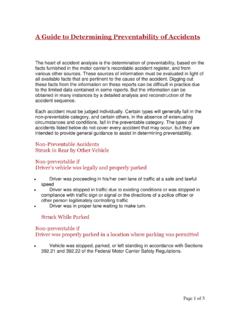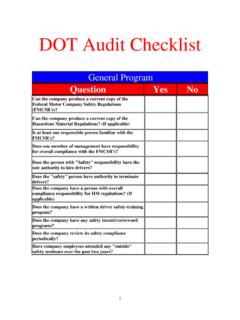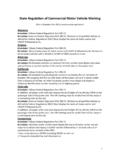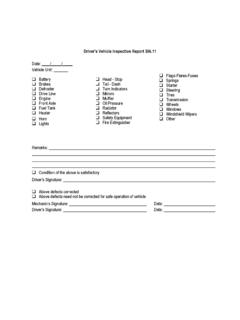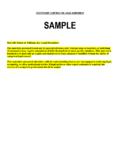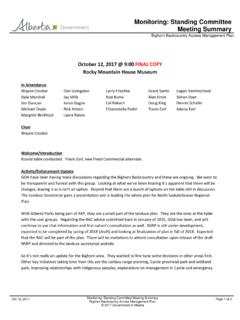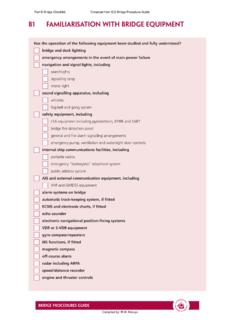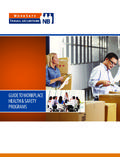Transcription of POST ACCIDENT CHECKLIST - DrivenbyMcGriff
1 Page 1 of 11 post ACCIDENT CHECKLIST Immediately after an ACCIDENT , have you: 1. Provided emergency medical assistance to anyone who is injured or ill? 2. Taken any necessary emergency action to prevent further injury or property damage? 3. Secured the scene to preserve the evidence for study? 4. Taken photos or measurements, if needed? 5. Interviewed and recorded witnesses contact information to determine what happened? 6. Interviewed others with relevant information and retained contact information? 7. Determined the cause(s) of the ACCIDENT ? 8. Filed other required reports? (Workers Comp, vehicle, property) 9. Is the ACCIDENT recordable on the company s ACCIDENT register? (See attached Appendix A) 10. Does the driver require a post - ACCIDENT test? (See attached Appendix B) 11.
2 Was the ACCIDENT Preventable? (See Appendix C) 12. Is the claim being processed by the insurance adjuster? 13. Is there a deductable that is charged back to a leased contractor? (See attached Appendix D) 14. Is there protocol requiring the ACCIDENT to be reported to other company managers? Page 2 of 11 APPENDIX A Recordable ACCIDENT Register Each carrier must maintain an ACCIDENT register when the ACCIDENT meets this criteria: (i) there was a fatality; (ii) there was bodily injury to a person who, as a result of the injury, immediately received medical treatment away from the scene of the ACCIDENT ; or (iii) one or more motor vehicles incurred disabling damage as a result of the ACCIDENT , requiring the motor vehicle to be transported away from the scene by a tow truck or other motor vehicle.
3 You must retain the information placed into the ACCIDENT register for a period of 3 years for all accidents after April 29, 2003. (49 CFR (b)) The ACCIDENT Register must include the following information: Date: Year of record Date of ACCIDENT City or Town and State Driver s Name No. of Injuries No. of Fatalities HazMat spills? Page 3 of 11 APPENDIX B Subpart C--- Tests required post - ACCIDENT testing (a) As soon as practicable following an occurrence involving a commercial motor vehicle operating on a public road in commerce, each employer shall test for alcohol for each of its surviving drivers: (a)(1) Who was performing safety-sensitive functions with respect to the vehicle, if the ACCIDENT involved the loss of human life; or (a)(2) Who receives a citation within 8 hours of the occurrence under State or local law for a moving traffic violation arising from the ACCIDENT , if the ACCIDENT involved: (a)(2)(i) Bodily injury to any person who, as a result of the injury, immediately receives medical treatment away from the scene of the ACCIDENT .
4 Or (a)(2)(ii) One or more motor vehicles incurring disabling damage as a result of the ACCIDENT , requiring the motor vehicle to be transported away from the scene by a tow truck or other motor vehicle. (b) As soon as practicable following an occurrence involving a commercial motor vehicle operating on a public road in commerce, each employer shall test for controlled substances for each of its surviving drivers: (b)(1) Who was performing safety-sensitive functions with respect to the vehicle, if the ACCIDENT involved the loss of human life; or (b)(2) Who receives a citation within thirty-two hours of the occurrence under State or local law for a moving traffic violation arising from the ACCIDENT , if the ACCIDENT involved: (b)(2)(i) Bodily injury to any person who, as a result of the injury, immediately receives medical treatment away from the scene of the ACCIDENT .
5 Or (b)(2)(ii) One or more motor vehicles incurring disabling damage as a result of the ACCIDENT , requiring the motor vehicle to be transported away from the scene by a tow truck or other motor vehicle. (c) The following table notes when a post - ACCIDENT test is required to be conducted by paragraphs (a)(1), (a)(2), (b)(1), and (b)(2) of this section: Page 4 of 11 APPENDIX B (continued) Table for (A) and (B) Type of ACCIDENT involved Citation issued to the CMV driver Test must be performed by employer i. Human fatality YES NO YES YES ii. Bodily injury with immediate medical treatment away from the scene YES NO YES NO iii. Disabling damage to any motor vehicle requiring tow away YES NO YES NO (d)(1) Alcohol tests. If a test required by this section is not administered within two hours following the ACCIDENT , the employer shall prepare and maintain on file a record stating the reasons the test was not promptly administered.
6 If a test required by this section is not administered within eight hours following the ACCIDENT , the employer shall cease attempts to administer an alcohol test and shall prepare and maintain the same record. Records shall be submitted to the FMCSA upon request. (d)(2) Controlled substance tests. If a test required by this section is not administered within 32 hours following the ACCIDENT , the employer shall cease attempts to administer a controlled substances test, and prepare and maintain on file a record stating the reasons the test was not promptly administered. Records shall be submitted to the FMCSA upon request. (e) A driver who is subject to post - ACCIDENT testing shall remain readily available for such testing or may be deemed by the employer to have refused to submit to testing. Nothing in this section shall be construed to require the delay of necessary medical attention for injured people following an ACCIDENT or to prohibit a driver from leaving the scene of an ACCIDENT for the period necessary to obtain assistance in responding to the ACCIDENT , or to obtain necessary emergency medical care.
7 Page 5 of 11 (f) An employer shall provide drivers with necessary post - ACCIDENT information, procedures and instructions, prior to the driver operating a commercial motor vehicle, so that drivers will be able to comply with the requirements of this section. APPENDIX B (continued) (g)(1) The results of a breath or blood test for the use of alcohol, conducted by Federal, State, or local officials having independent authority for the test, shall be considered to meet the requirements of this section, provided such tests conform to the applicable Federal, State or local alcohol testing requirements, and that the results of the tests are obtained by the employer. (g)(2) The results of a urine test for the use of controlled substances, conducted by Federal, State, or local officials having independent authority for the test, shall be considered to meet the requirements of this section, provided such tests conform to the applicable Federal, State or local controlled substances testing requirements, and that the results of the tests are obtained by the employer.
8 Page 6 of 11 APPENDIX C The former requirement for reporting accidents to the Federal Motor Carrier Safety Administration (FMCSA) ( ACCIDENT notification under 49 CFR Part 394) has been replaced with a new requirement for retaining and analyzing ACCIDENT information. Background As part of the ongoing FMCSA safety management effort to reduce the number of vehicle accidents on highways, assistance by safety specialists in ACCIDENT analysis and countermeasures planning is now an integral part of compliance reviews conducted by the FMCSA. ACCIDENT countermeasures are examples of defensive strategies designed to reduce preventable accidents. Purpose This information is designed to provide motor carriers and drivers with an introduction to the concepts of preventability analysis and ACCIDENT countermeasures.
9 The material suggests practical measures that can be taken now to prevent accidents, though its main intent goes further. The core of the presentation is a series of case histories of successful countermeasures. These are true stories of industry successes in promoting highway safety. The case histories are presented, together with a guide called Determining Preventability of Accidents, to help readers analyze accidents and create strategies to keep similar accidents from happening in the future. The FMCSA intends to stimulate thinking and discussion about ACCIDENT preventability and prevention within the motor carrier industry. The preventability guide and the ACCIDENT Countermeasures cases are not rating sheets nor orders from above to be followed exactly. They are guidelines and discussion tools to help carriers and drivers look at their unique operations and practices with an eye to identifying opportunities to make safety improvements.
10 Determining preventability No two accidents or carriers are exactly alike, and the FMCSA recognizes that not all accidents are preventable. Some types of accidents, furthermore, can be prevented by drivers, while others require changes in motor carrier practices and policies or equipment. The new FMCSA method for determining preventability is based on examination of the facts in ACCIDENT records. Page 7 of 11 Cases and countermeasures The countermeasures cases in this file actually occurred. They are true success stories that show how relatively modest improvements led to significant reductions in ACCIDENT rates. APPENDIX C (continued) Contents This section contains A Guide to Determining Preventability of Accidents and ACCIDENT Countermeasures. A Guide to Determining Preventability of Accidents The heart of ACCIDENT analysis is the determination of preventability, based on the facts furnished in the motor carrier's recordable ACCIDENT register, and from various other sources.
